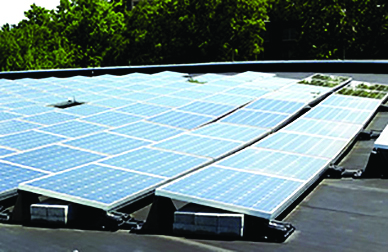
Courtesy NYSERDA
By Paul Post
Community solar is a large array of solar panels at an offsite location that allows customers to access such power without installing panels on their homes. Developers build and operate community solar projects, and energy delivery companies like National Grid purchase and distribute credits generated by the projects to participating customers.
It’s an easy way for residential and small business owners alike to offset the current 8.5 rate of inflation by shaving up to 10 percent off their electric bills.
“There’s very little downside with this,” said Nathan Giebel, EnergyNext LLC vice president of energy services. “It’s a win-win, which is why they’re so popular. We partner with a lot of chambers of commerce. That’s how a lot of businesses come to interact with us.”
EnergyNext is a division of Chicago-based Satori Energy and has an office in Saratoga Springs.
There are three main issues the firm helps clients navigate when deciding which community solar project to enroll in.
“The biggest thing people care about is, How much am I going to save? What’s the guaranteed savings percentage? Most are 10 percent. Some are 5 percent. If you see something less than 10 percent, there’s probably something better available,” Giebel said.
Second, contracts are typically long term, perhaps up to 20 years. So clients might want to know if it’s possible to get out of an agreement without incurring any fees. Giebel said this is usually possible, with a 60- to 90-day advance notice window.
And third, customers want to know how they’re going to be billed. In some cases, they’re sent a second invoice in addition to their regular utility bill, a situation most people want to avoid. So Giebel suggested finding a project that involves just one invoice.
National Grid, simply because of its large service area, has the most opportunities for community solar in upstate New York.
Typically, each project has a large anchor tenant such as a municipality or hospital, which has good credit and uses a lot of energy. This takes a certain degree of risk off the table by ensuring the project has a reliable source of income. The large anchor tenant may use 60 percent of the solar project’s electric generation. The rest is divvied up among residential and small business users, which must average less than 25 kilowatts of usage.
“The state requires that a certain percent of each project’s solar power be available to small users,” Giebel said. “We currently have three partners available for subscription in the National Grid service area. There’s pretty good availability right now.”
To get started, EnergyNext first confirms that a potential client is eligible for community solar by checking their electricity usage. “We need a recent invoice,” Giebel said. “Then we’ll send them a PDF contract or enrollment link depending on who the provider is with the best opportunity.
“If a solar project is already active, customers can start seeing savings within two to three months of signing a document. If the solar project is still in development, it could be six to 12 months depending on the project timeline. We try to get people in sooner rather than later.”
The National Grid website provides an easy, step-by-step process for getting enrolled in community solar.
National Grid says this a good time to shop for solar, for three main reasons. They are:
• Attractive incentives are offered such as the federal investment tax credit, which was extended with the Inflation Reduction Act, meaning users have more time to claim the tax benefit, which provides a tax credit of 30 percent for most solar shoppers.
• Second, by reviewing multiple quotes by vetted installers people are able to save about 20 percent from average market pricing.
• Third, people may begin the process of shopping for solar now and plan for an installation later this year, to take advantage of the low costs and best financial incentives.
Earlier this year, National Grid and the New York State Energy Research & Development Authority (NYSERDA) launched a Solar-For-All program that automatically provides monthly credits to nearly 175,000 income-eligible customers enrolled in National Grid’s Energy Affordability Program.
Expanded Solar-For-All is designed to deliver the benefits of community solar to low-income customers, who are often shut out of renewable energy sources due to cost.
To meet the goals outlined by the Climate Leadership and Community Protection Act (CLCPA), New York is required develop 10 gigawatts of distributed solar projects by 2025, and 70 percent of the state’s electricity must come from renewable energy sources such as wind and solar, by 2030. The CLCPA also requires at least 35 percent of clean energy program benefits to be directed to low-to-moderate income customers.
